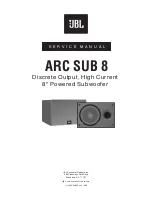
4
[INSTALLATION GUIDELINES]
When selecting a location to install the woofer, it is recommended the woofer be located near the left and right front speakers, near the floor or ceiling and
close to a side wall. Avoid placing the woofer in the center of the wall, the center of the room, or on an opposite wall whenever possible. Room placement
will affect the output of the IW200.
Before beginning your installation, it is recommended that you measure the bay (the space between studs) you intend to install the woofer enclosure.
Although 16” centers are the standard for framing construction, you will likely find many variations. For the simplest installation and best results, select
a bay that is clear of any obstructions like electrical wiring, gas or water pipes. The woofer enclosure is intended to rest on the bottom plate between
vertical studs. The bottom (toe) plate is the 2” X 4” stud lying on the floor, to which the vertical studs supporting the wallboard are nailed. The height of
the actual woofer in the enclosure was selected to allow the woofer-mounting flange used to mount the subwoofer system, to provide adequate clearance
for decorative base molding up to 6” wide.
Note: Installation of the subwoofers requires six (6) 2 1/2” drywall or deck screws to secure the subwoofer enclosure between the wall studs;
and butt connectors, wire nuts, solder, and electrical tape, or solder and heat-shrink insulation are recommended to make the electrical con-
nections to the amplifier (supplied by the installer).
Note: In custom homes, the base molding may be wider than 6” requiring a cutout around the mounting flange. You may wish to raise the
woofer enclosure slightly above the bottom plate. Consult the general contractor if this is a concern.
Choose the appropriate mounting location for each speaker.
NOTE:
When deciding upon a location, consider the following:
• Be certain your speaker wires can be run to or are accessible from these locations.
• Make certain the wall or ceiling material is sturdy enough to support the weight and vibration of the speakers.
• Be certain the area behind the speaker is free of obstacles such as wall studs, electrical wiring, pipes, etc.
• Each speaker should be positioned properly, relative to the listening area for good coverage.
[ENCLOSURE AND WOOFER INSTALLATION]
STEP 1:
Open each end of the carton and slide the woofer enclosure out of the carton.
Note: Do NOT pull the woofer enclosure from the packing carton using the speaker wires as a handle.
STEP 2:
Once the enclosure is placed between the framing, run screws through the stud and into the cabinet. We suggest no less then 6 per side. This
will retain the woofer enclosure in place and prevent it from vibrating against the studs. The wood baffle over the opening in the enclosure is to be used
as a guide for cutting a through hole in the drywall
(Fig. 1)
. This needs to be removed after the drywall is up and when you are ready to install the IW 200
Subwoofer Flange and driver assembly into the enclosure.
STEP 3:
Once the enclosure is in place you are ready to connect the speaker leads to the amplifier leads. The wire in the enclosure is 16-Gauge plenum
rated UL approved stranded copper wire. You may make connections a number of ways including butt-connectors, wire nuts, electrical tape and solder.
Soldered connections with heat-shrink insulation, is the recommend way to splice the amplifier and woofer wires. Please note the (+) terminals are
indicated with a red wire.
Note: Low voltage electrical codes differ by state. Check your local low voltage code before selecting a method of wire splicing.
The drywall
must be installed with the opening for the speaker to proceed to the next step.
STEP 4:
Carefully remove the speaker baffle from the aluminum frame assembly and set aside. Remove the flange assembly from the packing carton.
The flange assembly must make a good seal to insure maximum performance. You will find two L-shaped foam gasket pieces in the bottom of the carton.
Peel the removable tape from the gasket and stick the adhesive side to the backside of the flange. Upon installation of the flange assembly gasket will
contact the front wall surface to form an airtight seal.
STEP 5:
When you remove the flange assembly from the packing carton, you will notice the screws
used to retain the clamp assembly are fully extended. To place the flange assembly into the wall push
the clamp assemblies toward the center of the flange opening; the holes in the flange will allow the
mounting screws to tilt toward the center opening enough to insert the flange assembly into the wall.
Insert the right side into the wall cutout and slide the complete assembly to the right. This will enable
you to then fit the left side clamp assembly into the cutout. Center the entire assembly in the opening.
STEP 6:
Pinch the self-aligning clamp assembly inside the enclosure until it contacts the backside of
the surface. This will force the three retaining screws to protrude from the front of the flange. Continue
to hold the clamp with one hand and use the electric screwdriver to tighten the center screw of the
flange. Once snug, repeat the procedure on the other clamp assembly. Using your level, verify the
mounting frame is correctly aligned in the opening. Make any necessary adjustments then tighten
the remaining screws until the frame is snug and securely clamping the enclosure board. Avoid over-
tightening the screws.
[FIG. 1]
Содержание IW200
Страница 1: ...OWNER S MANUAL INSTALL GUIDE CI CUSTOM INSTALL SERIES IW200...
Страница 6: ...8...
























